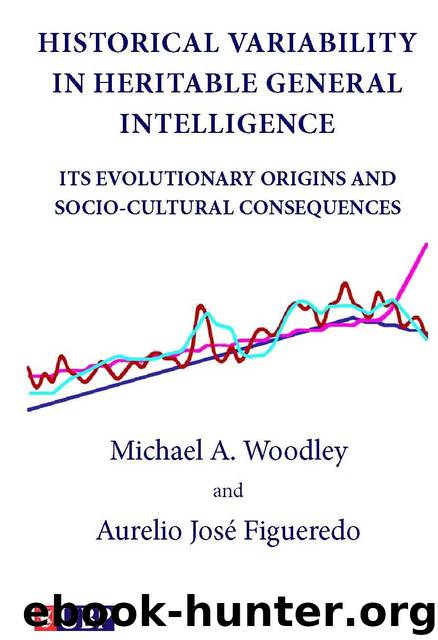Historical Variability in Heritable General Intelligence;:Its Evolutionary Origins and Socio-Cultural Consequences by Michael A. Woodley & Aurelio José Figueredo

Author:Michael A. Woodley & Aurelio José Figueredo [Woodley , Michael A.]
Language: eng
Format: epub
Publisher: The University of Buckingham Press
Published: 2013-05-01T04:00:00+00:00
4.2 Objections: Alternative Models of Declining Rates of Innovation
Interestingly, there appears to be something of an ‘emerging consensus’ on the reality of declining per capita levels of significant innovation (e.g. Arbesman, 2011; Cowen, 2011; Horgan, 1997; Huebner, 2005; Jones, 2009; Kasparov, Levchin & Thiel, 2012; Murray, 2003). However most researchers in this field attribute the declines to causes other than dysgenesis. These alternatives include the ‘low hanging fruit’ model, which suggests that innovation is getting harder simply because we are exhausting the space of possible innovation (Arbesman, 2011). Another model is that ‘economic limits’ are starting to exert their toll in as much as the profitability of further innovation is subject to diminishing returns (e.g. Cowen, 2011; Huebner, 2005). Variations on this theme include the idea that growth in the state sector has ‘crowded out’ private sector funding for the sciences, which has in turn negatively impacted innovation (Kasparov, Levchin & Thiel, 2012; Kealey, 1997), or alternatively that some combination of overly strict or poorly enforced intellectual property rights have stifled innovation in technology (e.g. Panagopoulos, 2004; Qian, 2007).
Yet another model posits that it is in fact ‘cultural malaise’ that is behind the decline in innovation, as people are increasingly subordinating rigorous personal standards of scientific enquiry to other ends (such as their careers, ideologies or bureaucratic norms; Charlton, 2012b; Murray, 2003). The problem with these alternatives is that they often assume that the intrinsic quality of human capital over time is either constant or increasing, and that the causes of the declines must therefore be attributable to extrinsic factors. We will here argue that many of these extrinsic factor driven models are nonetheless compatible with the reality of a dysgenic trend. A low hanging fruit may for example be within easy reach of someone of sufficient intellectual ‘stature’, but not to those of lower ‘stature’. A decline in intellectual ‘stature’ could easily therefore be the root cause of once low hanging fruit no longer being within grasping distance.
It is not likely therefore that the space of major scientific and technological innovation is simply becoming generally exhausted, as Horgan (1997) and Arbesman (2011) have argued. In some sub-fields it is true that the innovation rate has slowed or even ceased simply because there are fewer or no discoveries left to be made (such as new stable chemical elements or large species of animal; Arbesman, 2011; Paxton, 1998), however these are a minority of cases. In even fewer instances does it appear to be the case that physical limits on technology have been reached. An example might include the observation that interest in the field of perpetual motion research ground to a halt for the most part with the realization that the laws of thermodynamics made such endeavours impossible. However, apparent physical limits are not always real physical limits. The physical limits imposed on computer processing efficiency by the use of triodes for example did not prevent William Shockley from developing the transistor, and in so doing altering the physical limits on processing massively.
Download
This site does not store any files on its server. We only index and link to content provided by other sites. Please contact the content providers to delete copyright contents if any and email us, we'll remove relevant links or contents immediately.
| Fossils | Game Theory |
| Genetics | Molecular Biology |
| Organic | Paleontology |
Sapiens: A Brief History of Humankind by Yuval Noah Harari(13987)
Sapiens by Yuval Noah Harari(5122)
Homo Deus: A Brief History of Tomorrow by Yuval Noah Harari(4689)
Pale Blue Dot by Carl Sagan(4614)
Livewired by David Eagleman(3534)
Origin Story: A Big History of Everything by David Christian(3472)
Brief Answers to the Big Questions by Stephen Hawking(3239)
Inferior by Angela Saini(3151)
Origin Story by David Christian(2991)
The Gene: An Intimate History by Siddhartha Mukherjee(2927)
Signature in the Cell: DNA and the Evidence for Intelligent Design by Stephen C. Meyer(2875)
The Evolution of Beauty by Richard O. Prum(2868)
Aliens by Jim Al-Khalili(2703)
How The Mind Works by Steven Pinker(2612)
A Short History of Nearly Everything by Bryson Bill(2506)
Sex at Dawn: The Prehistoric Origins of Modern Sexuality by Ryan Christopher(2413)
From Bacteria to Bach and Back by Daniel C. Dennett(2390)
Endless Forms Most Beautiful by Sean B. Carroll(2350)
Who We Are and How We Got Here by David Reich(2342)
